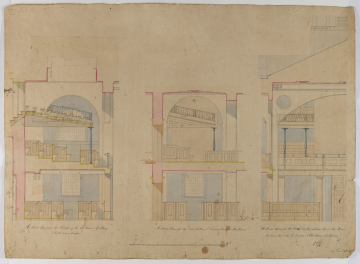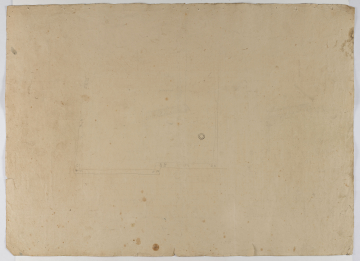
Browse
Reference number
Purpose
Aspect
The central elevation is similar to the one on the left, but the box pews are close with only one profile of a seat shown at nave and at gallery level. The metal column supports the organ gallery. Only the window at nave level is shown
The right is an axial view of one half of the western end of a church. The nave has pews across the front with Doric columns behind supporting the gallery. A panelled door is next to these. The gallery has an arch with an oculus across the top and a panelled balustrade across the bottom. Behind are a pair of metal columns supporting the childrens' gallery, which has a strigilated guard rail. Behind the posts are the pews for the organ gallery. Above is an outline of a pitched roof and the base of the tower
Scale
Inscribed
Signed and dated
- 19 January 1826
19th. Jany. 1826_
Medium and dimensions
Hand
Soane Office Day Book for 13 January 1826 has Richardson, Burchell, Mocatta and Davis working on copying drawings for Marylebone Church. The letter types such as the C and looped h are more typical of Mocatta’s hand
Verso
Watermark
Level
Sir John Soane's collection includes some 30,000 architectural, design and topographical drawings which is a very important resource for scholars worldwide. His was the first architect’s collection to attempt to preserve the best in design for the architectural profession in the future, and it did so by assembling as exemplars surviving drawings by great Renaissance masters and by the leading architects in Britain in the 17th and 18th centuries and his near contemporaries such as Sir William Chambers, Robert Adam and George Dance the Younger. These drawings sit side by side with 9,000 drawings in Soane’s own hand or those of the pupils in his office, covering his early work as a student, his time in Italy and the drawings produced in the course of his architectural practice from 1780 until the 1830s.
Browse (via the vertical menu to the left) and search results for Drawings include a mixture of Concise catalogue records – drawn from an outline list of the collection – and fuller records where drawings have been catalogued in more detail (an ongoing process).




